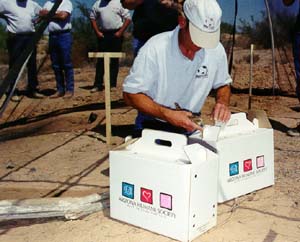 |
Bob Fox from Wild At Heart is shown
removing a Burrowing Owl from a carrier for release inside the
tent. Four burrow openings are available to the birds in each
tent along with numerous perches. Wild At Heart had previously
rescued Burrowing Owls in the way of housing developments near
Phoenix, Arizona. The owls are kept at Wild At Heart's rehabilitation
facility in Cave Creek, Arizona awaiting release back to the
wild. Where possible, burrows can be installed near the new development
and the birds released there. Where that is not possible the
birds can be released into a tent to build "site fidelity"
for the new home. If the owls stay at the site long enough they
will become attached to the new site and will not leave when
the tent is removed (so long as the conditions are favorable
for food and habitat). |
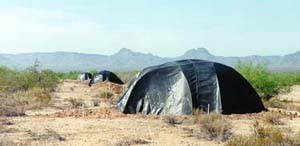 |
Three
of the four tents erected at the Red Hawk site. The tents were
separated by 100 meters. Each tent enclosed four burrow entrances
and between the tents were additional groups of four burrows.
One of the important features of this site is to provide a surplus
of burrows to allow for choice, and room for colony expansion. |
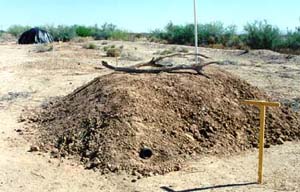 |
This shows one of the four above-ground
burrows with a tent in the background. Note that there is a burrow
entrance close to the ground with a perch near the entrance for
the sentinel male. Between the mound and the tent are additional
burrows. |
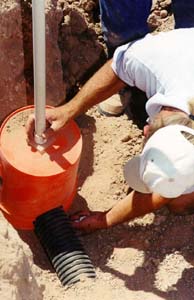 |
Here Bob Fox of Wild At Heart places Burrowing Owl eggs inside
a burrow. After the eggs are safely inside, the burrow is covered
and the female Burrowing Owl is released in the tent at the correct
entrance to allow her to resume brooding the eggs. This procedure
became necessary when one of the rescued owls began nesting at
the rehabilitation facility. The tent was erected over the burrow
entrance but the burrow itself was left uncovered. This made
it possible to quickly place the eggs, cover the burrow, and
reunite the brooding female owl by releasing her into the correct
entrance inside the tent.
|
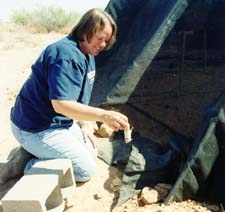 |
Here an APS volunteer brings a mouse
to a tent. Every morning for a little more than a month, one
of the volunteers brought enough mice to each tent to feed all
the owls. A feeding station is located just inside the edge of
the tent to provide a shaded, clean spot to leave the food and
a bowl of water. This way the volunteer does not have to risk
entering the tent and possibly allow a bird to sneak out. It
is possible to provide the food and water through an opening
only big enough for a hand and arm. |
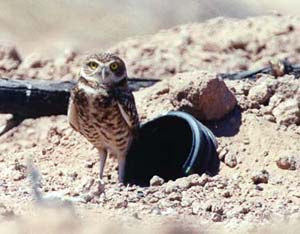 |
Eventually, the tents are removed
and the owls can select a burrow of their choice. Here is an
owl that decided one of the burrows away from the "tent"
burrows was best. The birds will frequent more than one burrow
and there is often more than one owl per burrow. |
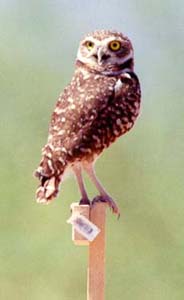 |
Here one of the owls is perched
on one of the "T" perches placed close to a burrow
opening. Typically, the sentinel male will be a lookout for predators
that pose a threat to the burrow or the colony. This behavior
not only benefits the owls, it also benefits ground squirrels
and other birds that hear the alarm call and flee to safety. |
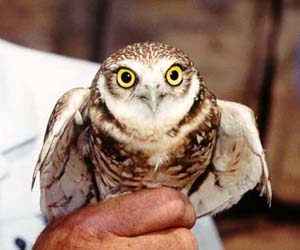 |
Bob Fox Holds a Burrowing Owl just
before release into a burrow entrance in a tent. |
|
|







